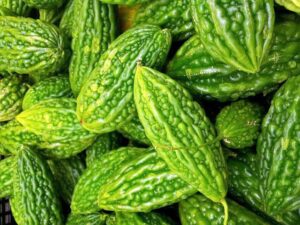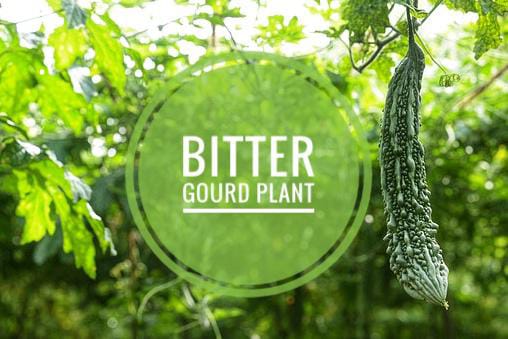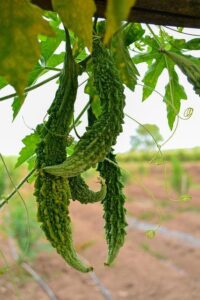Are you curious about growing Bitter Gourd Plant at home but unsure where to begin? Many gardeners are drawn to this plant for its unique taste, powerful health benefits, and fast-growing vines.
If you’ve come here searching for a complete guide to the bitter gourd plant, you’re in the right place. We’ll cover everything from its origins and growing conditions to varieties, care tips, and common problems. By the end, you’ll feel confident to start growing this remarkable plant in your own garden.

Introduction
Bitter gourd (Momordica charantia) is a tropical and subtropical vine belonging to the cucumber family. It produces distinct warty fruits with a bitter taste, which are valued for both culinary and medicinal uses. Known by many names, such as karela in India, balsam pear in the Caribbean, and ampalaya in the Philippines, it has traveled across cultures and cuisines.
Let’s start with a quick overview of the bitter gourd plant in a simple table.
| Attribute | Description |
|---|---|
| Common Name | Bitter gourd / Bitter melon / Karela |
| Scientific Name | Momordica charantia |
| Family | Cucurbitaceae (Cucumber family) |
| Plant Type | Climbing vine |
| Native Region | Africa and Asia |
| Growth Habit | Annual, fast-growing climber |
| Fruit Shape | Oblong, ridged, or spiny |
| Taste | Distinctly bitter |
| Edible Parts | Fruit, young shoots, and leaves (in some cuisines) |
| Lifespan | 3–4 months (seasonal crop) |
History and Origin
The bitter gourd plant has an ancient history that stretches across continents. It is believed to have originated in Africa, later spreading to Asia through trade and migration. Historical texts suggest that bitter gourd was cultivated in India over 600 years ago, where it became a staple in Ayurvedic medicine.
Its name comes from the Latin word momordicus, meaning “to bite,” which refers to the jagged appearance of its leaves and fruits. Across Asia, it carries cultural significance as both food and medicine. In China, it is a traditional summer vegetable, while in India, it is valued for controlling blood sugar.
Today, bitter gourd is widely grown in tropical regions around the world, with strong roots in traditional remedies, cuisines, and agricultural practices.
Growing Conditions
Bitter gourd thrives in warm, sunny conditions and grows quickly once established. To cultivate it successfully, we must provide the right soil, water, and care.
Soil
Bitter gourd prefers well-drained, sandy or loamy soil with high organic matter. The ideal pH range is between 5.5 and 6.7. Adding compost or aged manure helps boost fertility.
Water
Consistent moisture is essential, especially during flowering and fruiting. However, waterlogging should be avoided as it can cause root rot. Deep watering two to three times a week usually works best.
Sunlight
This plant loves full sun. At least 6 to 8 hours of direct sunlight daily will ensure healthy vines and abundant fruits.
Temperature
The ideal growing temperature is between 24–30°C. Bitter gourd is highly sensitive to frost and cold weather, so it must be grown in warm climates or during summer.
Varieties
Bitter gourd has many varieties, each with unique fruit shapes, sizes, and flavors. Some are small and spiny, while others are long and smooth. Here are a few popular types:
- Indian Varieties – Typically smaller, spiny fruits with pronounced bitterness. Widely used in Indian cooking.
- Chinese Varieties – Longer, smoother fruits with lighter bitterness. Often stir-fried or added to soups.
- Hybrid Varieties – Developed for higher yields, disease resistance, and uniform fruit shapes. Examples include Priya and CO 1.
- Regional Varieties – Different areas have their own local strains, such as Konkan Tara in Maharashtra or Pusa Do Mausami in northern India.
Each type has its own appeal depending on culinary preferences and growing conditions.
Care Tips
To get the most out of your bitter gourd plant, regular care and attention are essential.
Pruning
Trim excess side shoots to encourage healthy fruiting. Removing old leaves also improves air circulation and reduces pests.
Repotting
If growing in containers, choose a pot at least 12–15 inches deep. Repotting is rarely needed as bitter gourd is seasonal, but ensure enough root space.
Fertilizing
Apply organic compost or well-rotted manure before planting. During growth, use liquid fertilizers rich in nitrogen and potassium every two weeks. Avoid excessive nitrogen, which encourages leaves but reduces fruit.
Propagation
Bitter gourd is grown from seeds. Soak seeds overnight to speed up germination. Sow directly into soil or containers about 1–2 cm deep.
Support
As a climbing vine, bitter gourd requires trellises or fences for proper growth. This also keeps fruits straight and prevents rotting on the ground.

Common Problems and Solutions
Like all plants, bitter gourd faces challenges from pests and diseases. Knowing how to spot and fix them early ensures a healthy harvest.
Pests
- Fruit flies: They lay eggs in young fruits, causing damage. Use pheromone traps or neem oil spray.
- Aphids: Small insects that suck sap from leaves. Control with insecticidal soap or neem oil.
- Red spider mites: Cause yellowing leaves. Spray with water or introduce natural predators like ladybugs.
Diseases
- Powdery mildew: White patches on leaves. Prevent with sulfur sprays or milk-water solution.
- Downy mildew: Yellowish spots with fungal growth. Improve air circulation and avoid overhead watering.
- Root rot: Caused by overwatering. Ensure proper drainage and avoid waterlogging.
Regular monitoring, organic sprays, and proper plant spacing go a long way in keeping problems under control.
Uses and Benefits
Bitter gourd is more than just a garden plant. It plays important roles in health, culture, and the environment.
Medicinal Uses
It is famous for controlling blood sugar levels, making it useful for diabetes management. The plant also supports digestion, boosts immunity, and acts as a natural detoxifier.
Culinary Uses
Despite its bitterness, it is loved in many cuisines. In India, it is stuffed, fried, or curried. In China, it is stir-fried with eggs or added to soups.
Ornamental Value
With its lush green vines and striking fruits, bitter gourd can be trained on trellises to add greenery and character to gardens.
Environmental Role
As a fast-growing vine, it provides shade, improves soil with organic matter, and supports pollinators like bees.
Cultural Significance
In some cultures, bitter gourd is considered auspicious and is used in traditional rituals and festive cooking.

Interesting Facts
Here are some surprising things you may not know about bitter gourd:
- Bitter gourd fruits contain twice as much beta-carotene as broccoli.
- The plant’s leaves and shoots are edible and used in teas or stir-fries.
- It is often called “vegetable insulin” due to its strong impact on blood sugar.
- In Ayurveda, bitter gourd is believed to balance the body’s pitta and kapha energies.
- The bitterness in the fruit comes from compounds called momordicin and charantin.
FAQs
Frequently Asked Questions
Q1. How long does bitter gourd take to grow from seed to harvest?
It usually takes 55–60 days from seed sowing to harvesting mature fruits. Proper care and good sunlight can speed growth.
Q2. Can we grow bitter gourd in pots or containers?
Yes, bitter gourd grows well in pots at least 12–15 inches deep. Provide a trellis for support and use nutrient-rich soil.
Q3. Why are my bitter gourd fruits turning yellow too early?
Fruits turn yellow when they are overripe or if the plant lacks nutrients. Harvest on time and provide balanced fertilization.
Q4. How often should I water my bitter gourd plant?
Water two to three times per week, ensuring the soil remains moist but not waterlogged. Increase watering during flowering and fruiting.
Q5. Is bitter gourd suitable for all climates?
Bitter gourd prefers warm, tropical, or subtropical climates. It struggles in cold weather and frost, so it’s best for summer growing.
Conclusion
The bitter gourd plant is a rewarding choice for any gardener. While its bitterness might not appeal to everyone, its health benefits and cultural value make it a true treasure. With the right care, sunlight, and support, you can enjoy fresh, homegrown bitter gourds within just two months.
If you’re looking for a plant that is nutritious, fast-growing, and adds character to your garden, bitter gourd is worth trying. Start small, care for it well, and soon you’ll be harvesting fresh fruits from your garden or yard.

